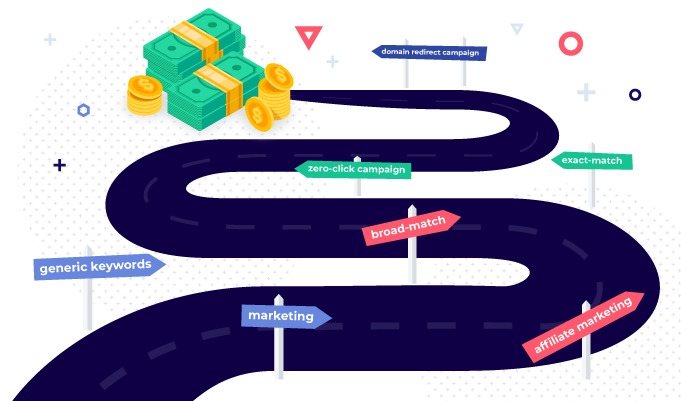The ultimate goal of any affiliate marketing campaign is to make profit. The ultimate goal of this article is to help affiliates like you reach that goal with domain redirect traffic (also known as zero-click traffic) campaign. Two things to bear in mind are campaign targeting and campaign optimization. Why? Because you need to meet the right traffic with the right offers.
To do exactly that, and also make affiliate marketer’s life easier, ad exchange platforms enable multiple options for tuning up your campaigns. It is worth to know, though, which options and set-up choices are best for the traffic you selected.
With zero-click traffic, which involves little user interaction as the name suggests, understanding its nature helps you figure out the best practices for your campaigns. Thus, good campaign optimization combined with proper targeting prevents you from wasting your resources and improves the results of your affiliate marketing campaigns.
What are the best campaign targeting options for domain redirect traffic?
Let’s talk targeting — campaign targeting is your chance for showing the right ads to the right users. The more customized targeting ad exchanges offer, the better. It is crucial, yet quite a complex step. Ad exchanges tend to vary in terms of technicalities so we cannot give you one, ready-made solution. What we can do is provide you with a few proven examples that may come in pretty handy.
Step one – choosing targeting options
First, decide which targeting option you want to go for:
- RON (Run-Of-Network): This option targets all traffic coming from a selected GEO. If a new source appears in this GEO, your campaign will start buying traffic from this new source as well. By running RON campaigns you’re able to distinguish the best performing targets and use them while running Target/Source campaigns. NOTE: There are two ways to use this information. The first option is to block the worse performing ones. The second option (recommended one) is to focus only on the well-performing sources/targets, meaning running WHITELIST campaigns.
- WHITELIST: To run a whitelist campaign you need to run RON first and identify a list of the best sources. It allows you to observe which sources/targets perform better than others. The difference between whitelist campaigns and a RON campaign with blocked targets/sources is that new sources/targets are continually added in the case of RON campaigns. As a result, you need to keep monitoring the campaign and block unwanted sources. Thus, running whitelist campaigns seems like an easier, faster and better solution.
- Keyword: This option targets traffic containing selected keywords or domains. You need to provide a list of keywords for this campaign to start receiving traffic. These may include generic, broad-match or exact-match keywords – depending on what you want to achieve with your campaign.
- Multi-geo: This option allows you to target several GEOs at once. If a new source appears in one of the selected GEOs, your campaign will start buying traffic from this new source as well.
Because of the nature of the domain redirect traffic (redirections often based on URL misspellings), we suggest going for Target and/or Keyword. Thanks to those, you’re able to select the best performing URLs and keywords that match the content of your ads with the place they’ll be shown.
Step two – boosting your zero click campaign right at the start
You can further improve your future results already while setting-up a zero-click campaign. The best targeting options for zero-click traffic are geolocation, device type, adult content filtering, frequency filters, day-parting, verticals.
Some ad networks offer more advanced features, such as Selected and Premium targets (especially useful for domain redirect traffic Target/Source campaigns) as well as Mobile Browser Blocking (meant to spare us unprofitable traffic).
Why should you keep an eye on your campaign targeting options? Because every one of them allows you to run tests and later decide where to pause and where to invest full steam ahead.
Let’s review selected targeting options that most ad platforms offer, so you can make the best choices for your affiliate marketing strategy and buy the best performing domain redirect traffic.
Geo-targeting: this option allows you to choose the country from which you would like to receive traffic, you can also narrow your targeting to given regions and cities.
Bid: it’s an average rate you’re willing to pay for an impression or a click. Tools like Traffic Calculator may be useful here, helping you estimate CPC (cost-per-click) and CPV (cost-per-view) bids for your affiliate campaigns. Note that domain redirects traffic works only on the CPV model.
Device Type (or Traffic Filters): this option allows you to choose what device to receive traffic from. Some ad exchanges provide advanced settings allowing you to pick e.g. mobile OS and versions, desktop OS, browser, carrier/Wi-Fi traffic, or specific carriers.
Frequency Filters: using “time” filters, you can choose how much time has to pass before a unique visitor sees your ad/page again.
Day-parting: allows you to decide when your campaign will be active and buy traffic only in specified time windows, according to a timezone of your choice.
Adult filtering: such an option allows you to choose whether your ads will be displayed on adult-sites, non-adult sites (mainstream), or on both. When targeting mainstream traffic, you must make sure not to include any adult content.
Vertical: a type of product you’re advertising (an offer is a specific product you’re advertising). Examples could be dating, e-commerce, betting, streaming, etc.
Read The Ultimate Guide To Domain Redirect Advertising Here!
How to optimize your domain redirect traffic campaign?
So your campaign is fully up and running. What happens now?
We’ve already established that proper campaign targeting is essential. The next step is domain redirect traffic optimization — make use of it to boost your campaign performance. In general, optimization is done manually. However, you can lift some weight off your shoulders with automation tools offered by several ad exchanges.
Examples could be AI-powered optimization tools and RBO (Rule-Based-Optimisation). Still, there are a few tricks that can be generally applied.

BID SMART, BID BIG
First things first — bidding. If you’re an experienced affiliate marketer, you probably know that bidding needs testing. If you’re a budding affiliate, then you’ve just learned another lesson. Here’s a couple more.
Placing high bids may expose your campaigns to traffic from more expensive sources, but the volume of traffic received stays the same.
The reason may be various levels of traffic prices based on targeting options (e.g. GEO or OS). This proves how important campaign targeting is if you want to bid your money smart.
A win ratio of particular targets and sources (determined by running RON campaigns whitelists) is a reliable source of information. Bid up on the best-performing targets and sources. If you keep on gaining traffic and the win ratio is growing, bid more. In this way, you enable more quality traffic for your campaigns, while making it unavailable to the competition.
KEYWORDS – the key to zero click traffic
What are ‘keywords’ in affiliate marketing? What keywords are the best to use in domain redirect traffic campaigns? It all depends on your targeting strategy, yet here are some answers.
Keywords may be anything you find useful for your campaign, be it domain redirect or any other in fact. With generic keywords or broad match keywords, your traffic search is much wider. Thus, if you go for ‘marketing’, you expose your campaigns to bigger volumes of traffic because you also receive traffic from ‘digital marketing’, ‘affiliate marketing’, ‘social media marketing’ etc. It is generally recommended to use short keywords unless you want to target a very specific niche. Then, exact-match keywords might be a better choice.
Misspellings are a huge thing when it comes to zero-click campaigns. Mistyping popular domain names/URLs, highly searched phrases, simply common words or popular foreign language words may bring huge volumes of relevant traffic.
So, why keywords are the key to running successful zero-click (domain redirect) campaigns? Because every time a user searches for something on the Internet or misspells a domain URL, it triggers traffic. And the possibilities are endless.
Landing profit
Landing pages are an essential part of every successful domain redirect campaign. Remember about the type of campaign you’re running, as the perfect lander varies depending on what is your ultimate goal. Some tried and tested tips would be clear CTA, crisp copy, minimal clicks, engaging visuals, relevant links – not too many. Also, a good lander should be quick to load, as we don’t want the user to close it before the ad is displayed.
DOs and DON’Ts
Here at Zeropark, we get asked about optimization every single day. If you’re looking for a quick summary, follow these dos and don’ts.
- Do run tests and optimize.
- Do your keyword research.
- Do carefully select your targets.
- Do track all possible parameters.
- Do learn and get experience on how, when and where to bid.
Don’t let others sweep your traffic before you do!
Check Out Domain Redirect Traffic Campaign
Kinga Gawron



